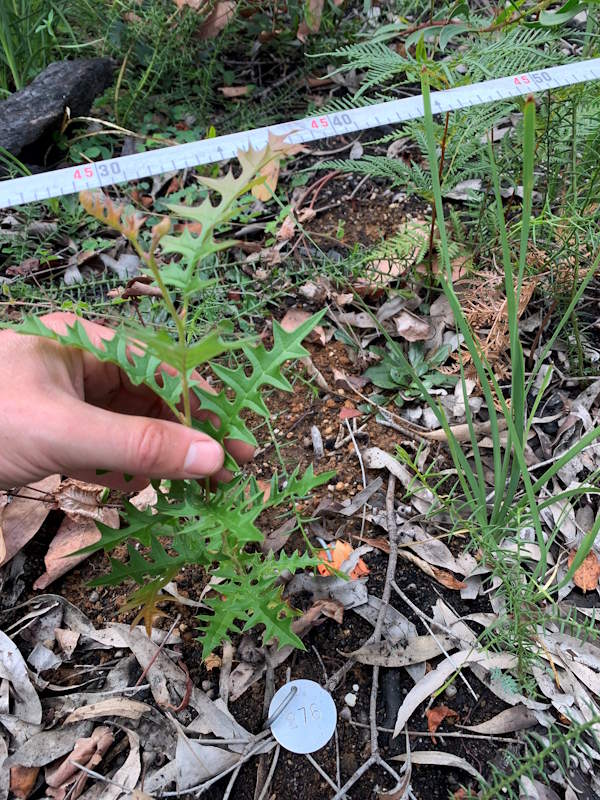In short
|
 Mt Cole Grevillea - photo by Steve Sinclair
Mt Cole Grevillea - photo by Steve Sinclair
What happened to the Mount Cole Grevillea?
Mount Cole Grevillea (Grevillea montis-cole subsp. montis-cole) is a shrub that grows up to 1 m high and is only found around Mount Cole in Western Victoria. The species can be found in either forest or among granite outcrops, living in populations as small as ten plants to others in the many thousands. Mt Cole Grevillea is listed as Critically Endangered under Victoria’s Flora and Fauna Guarantee Act 1988 (FFG Act).
On the 22nd of February 2024, the Baynindeen-Rocky-Road wildfire swept through Mount Cole and burnt all known populations. Monitoring immediately after the fire confirmed that all burnt plants were killed, leaving behind only the seed bank in the soil.
Fortunately, by August 2024, thousands of seeds began to germinate in areas where adult plants were present before the fire. With the whole population now consisting of just seedlings, it is particularly vulnerable to threats. Some of these threats are:
- premature return of wildfire, which may kill the young plants before they are able to reproduce and replenish the soil seed bank
- browsing by wallabies and deer
- Cinnamon Fungus (Phytophthora cinnamomi) which can kill plants
- leaf damage from the pest ‘Grevillea Leaf Miner’, which skeletonises the leaves and reduces the plants’ ability to grow
- unfavourable climate conditions such as drought, which may heavily impact young plants.
What we are doing
With our partners from DEECA Biodiversity Division, DEECA Grampians Region, Eastern Maar Aboriginal Corporation, and Royal Botanic Gardens Victoria, we are helping this species recover and monitor its progress. The work has been supported by the Australian Government’s Saving Native Species Program.
Monitoring plant growth and threats
To reduce browsing by deer and wallabies, DEECA installed fencing to protect large portions of the two largest Grevillea populations. ARI has tagged 200 individual plants inside and 200 plants outside the fences, and we are tracking how well they survive, grow and flower. This will provide insights to the impacts of browsing pressure and inform future management.
Over time, the measurements of plant growth will help us understand how long the species takes to mature and produce enough seed to replenish the seed bank. This will, in turn, help future fire planning and risk assessment.
Early monitoring results show that in the larger populations, about 95% of the plants inside and outside the fences survived their first summer. Some of the plants that were not protected by fencing have been broken and browsed, but they have mostly survived.
We also monitored smaller numbers of plants that grow scattered on high rocky outcrops. For these plants, the dry summer was far more challenging, and 46% of all tagged plants did not survive their first summer. Thankfully, the large number of germinants that appeared after the fire means there are many more plants growing on the rocks now than before the fire.
 Measuring Mount Cole Grevillea seedling - photo by Steve Sinclair
Measuring Mount Cole Grevillea seedling - photo by Steve Sinclair
Salvaging seedlings
We noticed that some seedlings germinated in areas where they would struggle to survive, including on road surfaces and road embankments that are routinely graded. Royal Botanic Gardens Victoria (Cranbourne Gardens and Victorian Conservation Seedbank) staff salvaged approximately 150 seedlings from these precarious locations to establish a long-term insurance population at the Gardens, which will also help ensure the survival of this species. One-hundred and twenty-four of these were planted back into the Mount Cole State Forest in July 2025 creating a new sub-population of the species, close to a small existing population. These individuals are fenced, and their progress will be monitored by ARI. The remaining salvaged plants will find new homes in the conservation collection at Royal Botanic Gardens Cranbourne.

Mt Cole Grevillea seedlings in Royal Botanical Gardens Cranbourne nursery. Photo by Andrea Keleher
What's next?
Our ARI botanists will continue to research and monitor the regrowth and regeneration of Mount Cole Grevillea over the several years. Our findings will help improve our understanding of their fire ecology and inform species management to recovery.
For more information contact Steve Sinclair, steve.sinclair@deeca.vic.gov.au or research.ari@deeca.vic.gov.au
Page last updated: 10/11/25